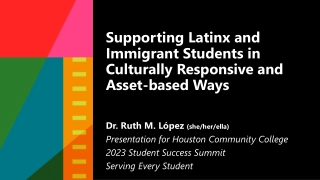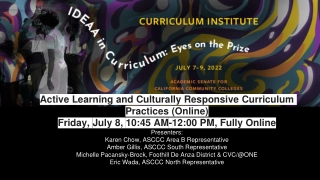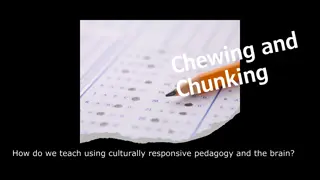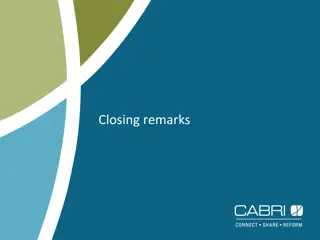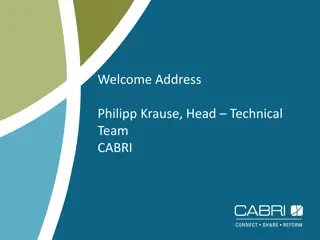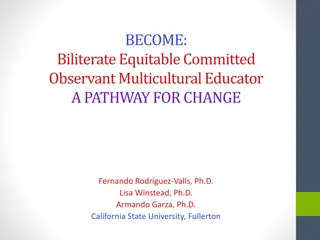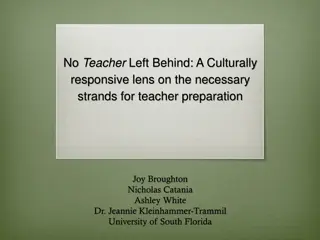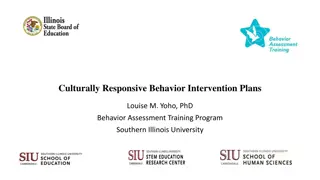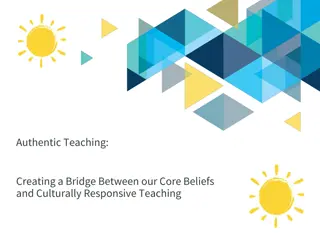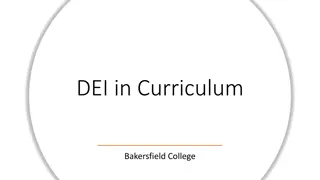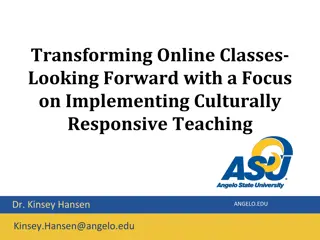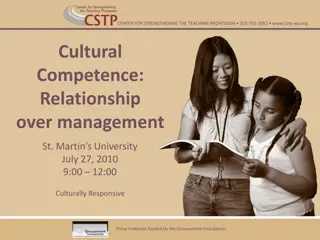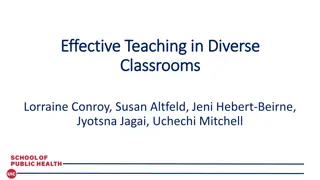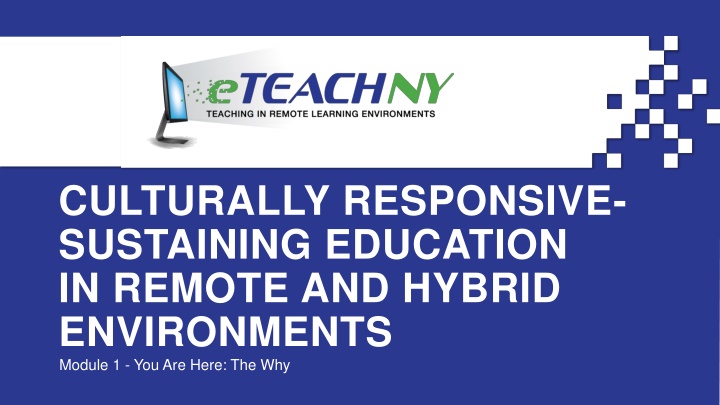
Culturally Responsive Education Importance
Culturally Responsive-Sustaining Education is crucial, especially in remote or hybrid learning settings. Explore the significance through immersive scenarios and reflections on equity vs. equality. Discover the value of promoting educational equity by leveraging student diversity as an asset.
Download Presentation

Please find below an Image/Link to download the presentation.
The content on the website is provided AS IS for your information and personal use only. It may not be sold, licensed, or shared on other websites without obtaining consent from the author. If you encounter any issues during the download, it is possible that the publisher has removed the file from their server.
You are allowed to download the files provided on this website for personal or commercial use, subject to the condition that they are used lawfully. All files are the property of their respective owners.
The content on the website is provided AS IS for your information and personal use only. It may not be sold, licensed, or shared on other websites without obtaining consent from the author.
E N D
Presentation Transcript
CULTURALLY RESPONSIVE- SUSTAINING EDUCATION IN REMOTE AND HYBRID ENVIRONMENTS Module 1 - You Are Here: The Why
The Why Why is Culturally Responsive Sustaining Education so important, especially when instruction shifts to remote or hybrid learning? This first module will explore the answer to that question. Please begin with the Immersive Scenario beginning on the next slide to provide you with a starting place in our exploration. Following the Immersive Scenario, you can engage with any of the tools in the remaining slides, in any order that you want. We only ask that you save the reflection for last! 2
Immersive Scenario Part 1 Stop and think: How would you feel? Reality TV! Imagine you are a contestant on a reality TV show where you and one other contestant have the opportunity to walk away with a million dollars. Do you think you can do it? What about this will be easy? What will be a challenge? The money is on the top of a two story building. You just have to climb up a ladder to reach it. And for encouragement, a coach is going to be calling out step, step, step, that s the way to help you succeed. 3
Immersive Scenario Part 2 Stop and think: Here s your reality, though. Your opponent s ladder is firmly planted on the street, leaning against the building, with all rungs intact. How do you feel? Do you think you will win? Do you think the contest is fair? Your ladder extends twenty feet below the ground, rising up through an underground vault through a hole in the street. Every few rungs are broken or missing. You're waiting to hear the "go" bell. 4
Equity vs. Equality - Introduction Watch the screencast: Objective To distinguish the difference between equity and equality and build a common understanding of educational equity. https://youtu.be/bntAdO9Ql_I Reflect on the questions on the next slide. OR Engage in an activity about the screencast above with a group of 3-4 or more of your peers, colleagues, and members of your professional learning network, using the collaboration protocols that begin on Slide 7. 5
Equity vs. Equality: Stop and Think (Key: T - Teachers, SL - School Leaders, DL - District Leaders) What is your current understanding of the word equity? How does it differ from equality? (T, SL, DL) How do you personally connect to the ideas in this video, what stood out to you the most? (T, SL, DL) What barriers might teachers face in achieving educational equity in the remote/hybrid learning environment? (T, SL) Although challenges/barriers exist and should never be disregarded or ignored, students also bring many individual strengths. How can the diversity of cultures, languages and lived experiences of students work as assets in promoting educational equity in classrooms? (T, SL) What is the value of having one common definition of educational equity within schools and districts, as opposed to differing definitions? (SL, DL) 6
Equity vs. Equality: Begin Placement Activity Collaborate Complete the Placemat Activity (continues on slides 8, 9, and 10) as a tool to build consensus. First, divide into small groups of 3-4. Decide who will take on each of the following roles in each group. Then, the reader should read the rest of the instructions. Timekeeper (sets a timer for each step) Reader (reads these directions to the group) Recorder (Records final group synthesis in center square) 7
Equity vs. Equality: Placemat Activity Write your responses to the following prompt(s) in your area of the placemat (examples on slide 9); during this time, no one should discuss yet (3 min.). In order to begin achieving educational equity, teachers must _________. Create a working definition of the word equity. At this point, definitions can be a work in progress as new insights and understandings are gained. If you finish early, keep adding thoughts to your area until it s time for group discussion. 8
Placemat Activity: Sample Arrangements The Placemat is a tool for formulating and organizing group thoughts, ideas and responses to questions. It can be structured in different ways depending on the number of group members and the physical arrangement of the group. 9
Equity vs. Equality: Sharing Out Each member should share his/her ideas. As a small group, in the center circle/square, synthesize your individual contributions into a group summary or consensus for the purposes of sharing (5 min.). Come together as a whole group and give highlights from each discussion by sharing the group consensus in the center square/circle from the small group discussion (5 min.). 10
Defining Culturally-Responsive Sustaining Education Objective: To define culturally responsive-sustaining education using 3 key aspects: partnerships, high expectations, and student-driven instruction. The information below is taken from NYSED Culturally Responsive-Sustaining Education Framework. The Culturally Responsive-Sustaining (CR-S) framework is intended to help education stakeholders create student-centered learning environments that affirm cultural identities; foster positive academic outcomes; develop students abilities to connect across lines of difference; elevate historically marginalized voices; This vision is grounded in Gloria Ladson-Billings early work on culturally relevant teaching, specifically the three criteria for culturally relevant pedagogy she puts forth in Ladson-Billings (1995). The New York State Culturally Responsive-Sustaining Framework includes guidelines for students, teachers, school leaders, district leaders, families and community members, higher education faculty, and Education Department policymakers. For guidelines to be effective, all stakeholders must work together, prioritize and implement systems and structures that facilitate the scale of culturally responsive-sustaining practices, and hold each other accountable to short- and long-term goals. 11
Defining C-RSE: Stakeholder Engagement When stakeholders work together to implement culturally responsive-sustaining practices, educators will grow in their ability to be: Socioculturally Responsive Socio-politically Conscious Commit to understanding the role of culture in education as flexible, local, and global Act as agents of social change to redress historical and contemporary oppression Build alliances across difference to eradicate all forms of discrimination Engage in current and historical issues Practice mutual respect for qualities and experiences that are different from one s own Demonstrate excellence by bring inclusive- minded and asset-focused Identify and critically examine both historical and contemporary power structures Reflect, honor, value, and center various identity perspectives as assets in policies and practices (Sue, 2001) Engage in critical conversations Recognize that personal, cultural, and institutionalized discrimination creates and sustains privileges for some while creating and sustaining disadvantage for others 12
Defining Culturally- Responsive Sustaining Education Detailed in Slides 14-19 are three key aspects that you will want to consider when you define culturally responsive- sustaining education: partnerships, high expectations, and student-driven instruction. 13
Defining C-RSE: Partnerships Student, teacher, and home partnerships In 2020, when schools first began to navigate remote instruction, the line between home and school blurred tremendously. School became each student's home; parents and caregivers were tasked with maintaining their child's learning environment in kitchens, spare rooms, on counters, tabletops, and in bedrooms. It's essential to recognize that parents and caregivers are the first and constant teachers in their child's life. As educators, we must build effective partnerships with parents and caregivers by engaging them in dialogue about their aspirations, hopes, and perspectives on their child. Their involvement must be beyond specific school functions or extracurricular activities; involve them daily and let them know their voice is essential. 14
Defining C-RSE: Stop and Think Stop and think: How do you currently (or will) learn about students cultures and communities? What do you do with that information? How is it integrated into your learning environment? How do you build and maintain positive and close relationships with students and their families? 15
Defining C-RSE: Language and Expectations The Language and Communication of High Expectations "When a teacher expresses sympathy over failure, lavishes praise for completing a simple task, or offers unsolicited help, the teacher may send unintended messages of low expectations." Kathleen Serverian-Wilmeth. It is critical to know that you may have students in your classroom that come from homes where the language and culture do not necessarily correspond to the language and culture of their school. This lack of alignment between home and school may be a disadvantage to students' learning process and cause them to be disengaged in school. 16
Defining C-RSE: Stop and Think The Language and Communication of High Expectations We come from different cultures, which means we learn differently and have differing expectations for learning. Consider, for instance, if students' cultural backgrounds have a foundation of cooperation and support within groups versus focusing on individuality and working independently. Or vice versa. Or, if students have a different set of expectations for eye contact, so they don t look you in the eye when you speak. These are just two considerations that can impact the advantage or disadvantage, students will have in your classroom. Stop and Think: What thoughts were ignited by the quote to start this section? How might you maximize the learning opportunities in your classroom based on the cultures represented? 17
Defining C-RSE: Student-Driven Instruction Rigorous Student-Driven Instruction "Authentic and relevant learning frame curriculum and content for students. A shift from traditional teacher-centered instruction to student-driven instruction should include a problem or challenge that students are addressing and aiming to solve. The inclusion of current events, community issues and needs, and projects related to social justice are all ways to provide students with rigorous instruction that can be culturally responsive. The shift from a teacher-centered to a student-driven classroom allows the teacher to leave the front of the room and directly engage with students during the learning process. The "guide on the side" can gain a clear sense of student learning and use that knowledge to drive instruction so that all students are challenged to reach their potential. 18
Defining C-RSE: Stop and Think 2 Rigorous Student-Driven Instruction Rather than leading a whole class lesson to convey a skill to students, the teacher crafts various learning experiences in which students engage to understand the content. As students work through these activities, the teacher can observe student interactions, assess mastery, and guide students toward a deeper analysis of concepts. Stop and Think: Do you consider your learning environment to be more teacher- centered or student-driven? Are there activities or times throughout the day that you lean more towards a student-driven environment? Why? 19
Culturally Responsive Teaching: The Why Watch the screencast: Objective To understand the importance of Culturally Responsive Teaching in building cognitive capacity in students from diverse backgrounds. https://youtu.be/P3U_jNOGzx8 An educator s ability to recognize students cultural displays of learning and meaning making and . . . use [it] as a scaffold . . . to promote effective information processing. All the while, the educator understands the importance of . . . having a social-emotional connection to the student in order to create a safe space for learning. -Hammond, Zaretta. (2015). Culturally Responsive Teaching & The Brain. 20
Culturally Responsive Teaching: Stop and Think (Key: T - Teachers, SL - School Leaders, DL - District Leaders) How is the definition of culturally responsive teaching provided by Zaretta Hammond similar to or different from your initial understanding of the term, culturally responsive teaching? (T, SL, DL) What key words of phrases stand out to you and why? (T, SL, DL) What do you see as a pivotal first step in being culturally responsive in the classroom? (T, SL) How might your culture and background influence the interactions, expectations and relationships you have with your students? (T, SL) Why are partnerships with families an important component of culturally responsive teaching and learning? What does partnership mean to you? What might partnership look like for your students and their families in a remote or hybrid learning environment? (T, SL) How would you define your own cultural identity, values and beliefs? How might this understanding of your identity influence the decisions you make for your school or district? (SL, TL) 21
Culturally Responsive Teaching: Collaborate Engage in a discussion about the screencast and questions above with your co-teacher, grade level team, department, or with someone in your professional learning network, using the collaboration protocols below. Decide who will take on each of the following roles in each group: Time Keeper: Manages the discussion by ensuring the discussion stays within the given time frame. Recorder: Writes and captures the notes from the discussion on the screencast, Culturally Responsive Teaching: The Why. Protocol Promoter: Reads the protocols on the next slide and ensures that the all members are following the protocols and allowed the opportunity to speak. After the Protocol Promoter reads all the protocols on the following slide, engage in a discussion about the screencast and questions above for 15 minutes. 22
Culturally Responsive Teaching: Protocols As you engage in the discussion, use the following protocols: Everyone actively listens to the speaker. Participants acknowledge what others say with supportive or challenging comments, utilizing positive language. Each new comment is related to prior comments or introduces a new idea that will further the conversation. Be mindful of who is speaking and encourage all participants to offer their opinions. 23
Culturally Responsive Teaching: Stop and Think Stop and think: After the discussion is over, take 10 minutes to complete the chart below: Now, after the discussion, I am thinking/realizing Before, I was thinking . 24
Equity vs. Equality: The Unequal Opportunity Race Watch the video: Objective To identify the obstacles affecting equity and equality in the context of educating our most vulnerable students. https://www.youtube.com/watch ?v=vX_Vzl-r8NY Stop and Think (Key: T - Teachers, SL - School Leaders, DL - District Leaders) What are your major takeaways, aha moments, and next steps from the video? (T, SL, DL) How can remote/hybrid instruction add a layer of obstacles for some of our most vulnerable students? (T, SL, DL) 25
Cultural Distance Calculator Objective: To identify similarities and differences between teachers and students to leverage and prioritize meaningful connections between learning and culture, language, and life experiences. Use the table on the next slide by placing an X or after reflecting on how similar you are to your students. Key: 1= extremely close 5= extremely different 26
Cultural Distance Calculator: Find Your Score How similar are you and your students 1 2 3 4 5 Totals Communities? In what areas are your highest scores? Familial structures? Peer interactions? Cultural/media influences? In what areas are your lowest scores? Language/dialects? Ways of problem-solving? What trends do you notice? Definition of success? Intrinsic motivators? Extrinsic motivators? Long-term goals? Adapted from Manny Scott, Even on Your Worst Day You Can Be a Student s Best Short-term goals? Hope Worldview? Values? Affiliations? 27 Social activities/hobbies?
Cultural Distance Calculator: Stop and Think (Key: T - Teachers, SL - School Leaders, DL - District Leaders) How can you leverage the similarities you have with your students in your learning environment? (T) How can you utilize your awareness of the differences that you have with your students and use it to build a connection and high social capital with your students? (T) How can you leverage the similarities and differences among teachers and students across the school? (T, SL) How can you utilize your awareness of the differences among teachers and students to create a learning environment that prioritizes connections between learning and culture, language, and life experiences for all learners? (T, SL) How can you advocate for a hiring pool and process that leverages similarities between building leaders, teachers, and students? (SL, DL) How can identifying similarities and differences among building leaders, teachers, and students create a district culture that prioritizes connections between learning and culture, language, and life experiences for all learners? (SL, DL) 28
Cultural Distance Calculator: Collaborate Complete the table above as a grade level team, co-teaching partnership, department, etc. and reflect on how your scores change as a partnership or team (you can use some, or all, of the reflection questions above). 29
Designing Equitable and Culturally Responsive Learning Environments Access to Technology and Learning Objective: To design a learning environment that promotes equitable access, equitable representation, and equitable opportunities for all learners. Not all students come to school with the same background, skills, learning styles, or prerequisite knowledge. Educational equity involves providing students with the supports that they individually need to succeed. Students Taking Charge (2nd Edition) Dr. Nancy Sulla 30
Designing Equitable and Culturally Responsive Learning Environments: Technology When designing an equitable and culturally responsive learning environment, technology is an integral consideration. Use the tables on Slides 31 and 32 to reflect on your current learning environment. Student Access to Materials What percentage of your students have access to technology outside of school? What percentage of your students have access to WIFI enabled devices outside of school? Are the technology use activities you designed accessible to all of your students at any time they need? What is the plan for your students who don t have technology or internet access outside of school? 31
Designing Equitable and Culturally Responsive Learning Environments: Access to Technology and Learning Individual Learning Path How is technology being leveraged to transform students learning experiences? How is technology being used to extend the curriculum so that students are exposed to a diversity of experiences, scenarios and representations? How are the learning needs of each student being met through the integration of technology? Using technology to make data-informed instructional decisions What data are you collecting from activities that students are engaged in? How are you using the social and academic data to make instructional decisions (lesson and unit planning, designing and administering assessments, etc.)? What are you learning about your students as they engage with various learning activities? 32
Designing Equitable and Culturally Responsive Learning Environments: Brainstorm and Design Access to Technology and Learning Brainstorm and Design: Consider the Getting to Know Your Class activities on Slides 33, 34, and 35 to move beyond equitable access to providing equitable representation and opportunities for all learners in your remote or hybrid environment Student culture and background Design an activity, such as a writing prompt or brochure, that allows students to express and/or illustrate their cultural or ethnic backgrounds. This could involve a parent/family interview to gather information they can use for their products about themselves. Then, reflect on how you can use this information throughout the year so each student in your class feels represented. Also, reflect on additional information needed to better understand your students. 33
Designing Equitable and Culturally Responsive Learning Environments: Language and Communication Access to Technology and Learning Communication is an important global skill that has evolved over the past couple of decades with the advancement of smartphones and social media. Understanding the nuances of how your students communicate with one another and the adults around them will give you further insights into each student. Reflect on the following questions: What languages do your students speak? How do your students communicate with one another and with the adults around them? What are some words or phrases that students use that are unfamiliar to you? What do you notice about the nonverbal cues that students use to communicate with one another and/or adults? How is conflict resolved? 34
Designing Equitable and Culturally Responsive Learning Environments: Student Life Experiences and Interests Access to Technology and Learning What do your students enjoy doing outside of school? What social media platforms do they use? What genre of movies, music, and TV do they enjoy? Design a student interest survey with questions like the ones mentioned above to target your students interests beyond school. Use this data throughout the year to create authentic lesson plans and design activities tailored to their interests and academic content. Relevancy matters to students and will lead to retention. 35
Designing Equitable and Culturally Responsive Learning Environments: Stop and Think Key: T- Teachers, SL School Leaders, DL District Leaders How can you leverage the similarities you have with your students in your learning environment? (T) How can you utilize your awareness of the differences that you have with your students and use it to build a connection and high social capital with your students? (T) How can you leverage the similarities and differences among teachers and students across the school? (T, SL) How can you utilize your awareness of the differences among teachers and students to create a learning environment that prioritizes connections between learning and culture, language, and life experiences for all learners? (T, SL) How can you advocate for a hiring pool and process that leverages similarities between building leaders, teachers, and students? (SL, DL) How can identifying similarities and differences among building leaders, teachers, and students create a district culture that prioritizes connections between learning and culture, language, and life experiences for all learners? (SL, DL) 36
Designing Equitable and Culturally Responsive Learning Environments: Collaborate Access to Technology and Learning Collaborate: Complete the tables above as a grade level team, co-teaching partnership, department, etc. and reflect on how your relationships and connections as a partnership or team affect equitable access, representation, and opportunities for all learners (you can use some, or all, of the reflection questions above). 37
Supporting Schoolwide Culturally Responsive Practices Objective Watch the video: To synthesize ways to incorporate student experiences, cultures, and strengths into the learning environment. https://www.youtube.com/ watch?v=ztnwmVBMfd0 Stop and Think (Key: T - Teachers, SL - School Leaders, DL - District Leaders) How can your students' lives and experiences enrich your virtual classroom? (T) What are some ways you can incorporate learning walks in your remote/hybrid classroom? (T, SL) How can you ensure a diversity of access points to your remote/hybrid lesson? (T) How are your students' individual cultures, languages, and experiences represented in your remote/hybrid classroom? (T) 38
Schoolwide Culturally Responsive Practices: Brainstorm Brainstorm and Design Think of a traditional learning walk. A group of teachers visit classrooms, take notes, discuss, and share observations and next steps with the rest of the staff. Now, re-imagine a learning walk with a more student-centered approach where a sample of students (gen-ed, IEP, ELL) complete a walkthrough with staff members. How could this look? How could this work in a remote/hybrid setting? How would this contribute to student voice in the academic and cultural practices of the school? 39
Lenses of Instructional Equity Objective: Use the 7 lenses of instructional equity to identify current issues within key areas of instruction and ways to address these issues. Think back to the scenario you engaged in at the beginning of this module. Reflect on the thoughts and emotions you felt seeing the condition of your ladder and the challenging task ahead of you. Just like your ladder, the issues surrounding the inequities in education must be addressed. How can you determine the strength and quality of your instructional equity implementation? As you continue to move forward in this course, consider IDE Corp. s Seven Lenses of Instructional Equity (Slide 41). 40
Lenses of Instructional Equity 41
Lenses of Instructional Equity: Brainstorm & Design Brainstorm and Design: Consider your instruction through the 7 lenses of instructional equity. Use the table on Slides 43, 44, and 45 to reflect on the questions below as you design a learning environment that supports Culturally Responsive-Sustaining Education and addresses these issues. What equity issues emerge in the remote/ hybrid environment? How can you directly address these issues in your learning environment? (direct) What are the things outside of your immediate control that would address these issues on a larger scale? (indirect) 42
Lenses of Instructional Equity: Issues Access Opportunity Access is often connected to opportunity because one must have the ability, permission, and tools to take advantage of an opportunity. What might hinder students from gaining access to high-quality education? Opportunity is a situation favorable for the attainment of a goal. We know that schools provide students with paths to college and career. The question is: Does every student have the opportunity to receive a high-quality education, with a plethora of diverse resources available? Issues: Issues: Addressing these issues: Direct Indirect Addressing these issues: Direct Indirect 43
Lenses of Instructional Equity: Representation The Three E s Representation Dr. Nancy Sulla talks about the three Es: engagement, empowerment, and efficacy in her book Building Executive Function: The Missing Link to Student Achievement. Equitable learning experiences promote students as independent learners and thinkers. Teachers empower students by resourcing them with the proper scaffolds they need to thrive in a learning environment. Representation truly matters! Every student should be able to see themselves represented in a positive way on the walls of your physical or virtual classroom, in the characters within the books they read, through a diversity of authors, and much more. Issues: Addressing these issues: Direct Indirect Issues: Addressing these issues: Direct Indirect 44
Lenses of Instructional Equity: Relationships Authentic, Relevant Connections Relationships What issues or topics are of most interest to students? What are the needs of their communities? How might you anchor the learning to students lives and experiences? Authentic and relevant connections between the curriculum and student experience increase student engagement. Building relationships to cultivate an environment of trust, safety, and respect must be a top priority. By doing so, teachers allow the space for students to engage in rigorous learning experiences. Get beyond the surface knowing of your students and find out who they are so that you can use their experiences to enrich the learning environment. Issues: Addressing these issues: Direct Indirect Issues: Addressing these issues: Direct Indirect 45
Lenses of Instructional Equity: Responsiveness Cultural Responsiveness Cultural responsiveness is the utilization of cultures and backgrounds to inform our instructional practices. The key is to focus on the roots of culture, as noted by Zaretta Hammond in her book Culturally Responsive Teaching and the Brain. The first step is awareness, but from there, teachers must intentionally plan and design learning environments with culture in mind. Issues: Addressing these issues: Direct Indirect 46
Lenses of Instructional Equity: Stop and Think Stop and think: What is one of your biggest takeaways from this module? What next steps will you take? 47

